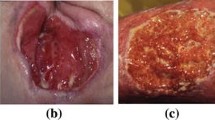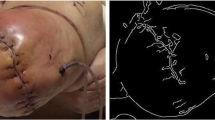Abstract
Telemedicine helps to deliver health services electronically to patients with the advancement of communication systems and health informatics. Chronic wound (CW) detection and its healing rate assessment at remote distance is very much difficult due to unavailability of expert doctors. This problem generally affects older ageing people. So there is a need of better assessment facility to the remote people in telemedicine framework. Here we have proposed a CW tissue prediction and diagnosis under telemedicine framework to classify the tissue types using linear discriminant analysis (LDA). The proposed telemedicine based wound tissue prediction (TWTP) model is able to identify wound tissue and correctly predict the wound status with a good degree of accuracy. The overall performance of the proposed wound tissue prediction methodology has been measured based on ground truth images. The proposed methodology will assist the clinicians to take better decision towards diagnosis of CW in terms of quantitative information of three types of tissue composition at low-resource set-up.





Similar content being viewed by others
References
Mustoe, T. A., O’Shaughnessy, K., and Kloeters, O., Chronic wound pathogenesis and current treatment strategies: a unifying hypothesis. J. Plast. Reconstr. Surg. 117:35–41, 2006.
Sharon, L.L., Shannon, R.D., Margaret, M., Heitkemper, L.B., Medical surgical nursing: assessment and management of clinical problems, 9th edn, pp. 179, 2015.
Anne, M. E., Louise, A. A., Chantal, M. A. M., Hester, V., and Dirk, T. U., Is the red-yellow-black scheme suitable to classify donor site wounds? An inter-observer analysis. J. Burns 37:823–827, 2011.
Chinmay, C., Bharat, G., and Soumya, K. G., Identification of chronic wound status under tele-wound network through smartphone. Int. J. Rough Sets Data Anal. 2(2):56–75, 2015.
Kidholm, et al., A model for assessment of telemedicine applications – MAST. Int. J. Technol. Assess. Health Care, 28:1, 2012.
AWMA National Committee, Australian Wound Management Association Telehealth Framework Document, Education and Professional Development Subcommittee (EPDSC), 2015.
Nick, S., Suzanne, K., TeleWound care – providing remote wound assessment and treatment in the home care setting: current status and future directions, Smart Homecare Technology and TeleHealth, pp. 35–41, 2013.
Whitney, J., Phillips, L., Aslam, R., Barbul, A., Gottrup, F., Gould, L., et al., Guidelines for the treatment of pressure ulcers. Wound Repair Regen. 14:663–679, 2006.
Hazem, W., Yves, L., and Sylvie, T., Enhanced assessment of the wound-healing process by accurate multi-view tissue classification. IEEE Trans. Med. Imaging 30(2):315–326, 2011.
Hsu, C. W., and Lin, C. J. A., Comparison of methods for multi-class support vector machines. IEEE Trans. Neural Netw. 13(2):415–425, 2002.
Mukherjee, R., Manohar, D.D., Das, D.K., Achar, A., Mitra, A., Chakraborty, C., Automated tissue classification framework for reproducible chronic wound assessment, Hindawi Publication Corporation, BioMed Research International, pp. 1–10, 2014.
Belem, B., Non-invasive wound assessment by image analysis, Ph. D. dissertation, School of Computing, Medical Imaging Group, Univ. Glamorgan, 2004.
Zaremba, M.B., Wielgos, A., Predicting outcome for hospitalized cardiac patients using a combined neural network and rough set approach. International Joint Conference on Neural Networks, 5: 3665–3668, 1999.
Dorileo, E.A.G., Frade, M.A.C., Roselino, A.M., Rangayyan, R.M., Marques, P.M., Color image processing and content-based image retrieval techniques for the analysis of dermatological lesions, Proc. of 30th Annual Int. Conf. of the IEEE Eng. in Medicine and Biology Society, pp. 1230–1233, 2008.
Xiong, W., Bair, A., Sandrock, C., Wang, S., Siddiqui, J., and Hupert, N., Implementing telemedicine in medical emergency response: Concept of operation for a regional telemedicine hub. J. Med. Syst. 36:1651–1660, 2012.
Chakraborty, C., Gupta, B., Ghosh, S.K., Tele-wound monitoring through smartphone, IEEE Int. Conf. on Medical Imaging, m-Health and Emerging Communication Systems (MedCom), pp. 197–201, 2014.
Lin, C. F., Mobile telemedicine: A survey. J. Med. Syst. 36:511–520, 2012.
Baig, M. M., and Gholamhosseini, H., Smart health monitoring systems: An overview of design and modeling. J. Med. Syst. 37(2):1–14, 2013.
Gagnon, M. P., Breton, E., Courcy, F., Quirion, S., Côté, J., and Paré, G., The influence of a wound care tele assistance service on nursing practice: A case study in Quebec. Telemed. J. e-Health 20(6):593–600, 2014.
Chanussot-Deprez, C., and Contreras-Ruiz, J., Telemedicine in wound care: A review. Adv. Skin Wound Care 26(2):78–82, 2013.
Chinmay, C., Bharat, G., Soumya, G., A review on telemedicine-based WBAN framework for patient monitoring. Telemed. e-Health, Marry Ann Liebert, Inc, 19(8): 619–626, 2013.
Chakraborty, C., Gupta, B., and Ghosh, S. K., Identification of chronic wound status under tele-wound network through smartphone. IJRSDA 2(2):58–77, 2015.
Chinmay, C., Bharat, G., and Soumya, K. G., Mobile metadata assisted community database of chronic wound. Int. J. Wound Med. 6:34–42, 2014.
Medetec wound database: Available via. http://www.medetec.co.uk/files/medetec_image_databases.html.
Li, S. H., Cheng, K. A., Lu, W. H., and Lin, T. C., Developing an active emergency medical service system based on WiMAX technology. J. Med. Syst. 36:3177–3193, 2012.
Lam, E.Y.; Combining gray world and retinex theory for automatic white balance in digital photography. Proceedings of the 9th International Symposium on Consumer Electronics, 14(16): pp. 134–139, 2005.
Gonzalez, R. C., and Woods, R. E., Digital image processing, 2nd edition. Prentice Hall, New York, 2002.
Chun, L. C., and Din, C. T., Color image enhancement with exact HSI color model. Int. J. Innov. Comput. Inf. Control 7(12):6691–6710, 2011.
Dunn, J. C., A fuzzy relative of the ISODATA process and its use in detecting compact well-separated clusters. J. Cybern. 3:32–57, 1973.
Bezdek, J. C., Pattern recognition with fuzzy objective function algorithms. Plenum Press, New York, 1981.
Konakala, S., and Putheti, S., A novel threshold technique and fuzzy C-means algorithm for segmentation of wound. Int. J. Comput. Appl. 84(7):12–14, 2013.
Campilho, E., Aurélio Kamel, E., Mohamed, R., Analysis of fuzzy clustering algorithms for the segmentation of burn wounds photographs. http://dx.doi.org/10.1007/11867661.
Wantanajittikul, K., Theera-Umpon, N., Auephanwiriyakul, S., Koanantakool, T., Automatic segmentation and degree identification in burn color images. Biomedical Engineering International Conference (BMEiCON), pp. 169–173, 29–31, 2012.
Yadav, M. K., Manohar, D. D., Mukherjee, G., and Chakraborty, C., Segmentation of chronic wound areas by clustering techniques using selected color space. J. Med. Imaging Health Inf. 3(1):22–29, 2013.
Duda, R.O., Hart, P.E., Stork, D.G., Pattern classification, 2nd ed, pp. 680, 2000.
Wannous, H., Treuillet, S., and Lucas, Y., Robust tissue classification for reproducible wound assessment in telemedicine environments. J. Electron. Imaging 19(2):1–9, 2010.
Acha B., Serrano C., Acha J., Segmentation and classification of burn images by color and texture information. J. Biomed. Opt. 10(3), 2005.
Chaudhary, P., Godara, S., Cheeran, A. N., and Chaudhari, A. K., Fast and accurate method for leaf area measurement. Int. J. Comput. Appl. 49(9):22–25, 2012.
Acknowledgments
The authors would like to acknowledge Dr. Subhas C. Choudhary, Surgeon, Skin Specialist, Jharkhand, India, for his valuable opinion to carry out this work.
Author information
Authors and Affiliations
Corresponding author
Ethics declarations
Conflict of interests
The authors declare that there is no conflict of interests regarding the publication of this paper.
Additional information
This article is part of the Topical Collection on Patient Facing Systems
Rights and permissions
About this article
Cite this article
Chakraborty, C., Gupta, B., Ghosh, S.K. et al. Telemedicine Supported Chronic Wound Tissue Prediction Using Classification Approaches. J Med Syst 40, 68 (2016). https://doi.org/10.1007/s10916-015-0424-y
Received:
Accepted:
Published:
DOI: https://doi.org/10.1007/s10916-015-0424-y




